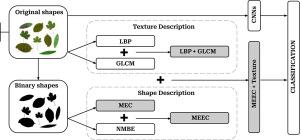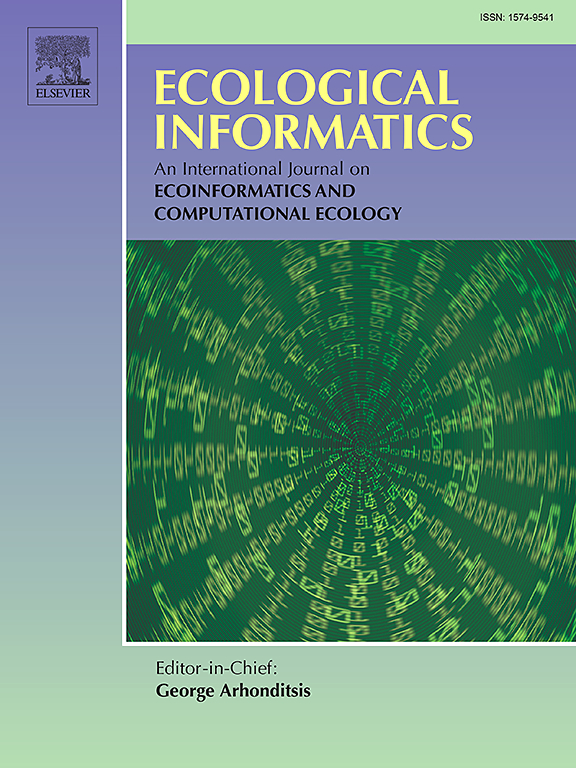Plant leaf classification using the multiscale entropy of curvature and feature aggregation
IF 7.3
2区 环境科学与生态学
Q1 ECOLOGY
引用次数: 0
Abstract
This paper presents a methodology for classifying plant leaves on the basis of handcrafted features derived from the multiscale entropy of curvature and texture, as well as deep features obtained from convolutional neural networks (CNNs). We propose three object descriptors on the basis of the multiscale entropy of curvature. These object descriptors rely on the differential entropy of the probability distributions of multiscale curvatures to create a coarse-to-fine representation of the shape contour. Thus, we present a descriptor that aggregates the multiscale entropy of curvature, bending energy of curvature, and texture features to improve feature extraction of object signatures and subtle texture details of leaf images. The texture descriptor combines the statistics of the local binary pattern and gray-level co-occurrence matrix. We compare our handcrafted descriptors with deep features from various CNNs in multiclass classification using the random forest classifier, replacing the fully connected layer of the CNNs with this classifier. The experiments were conducted on four public leaf datasets: Plantscan, MED117, Flavia, and Swedish. The results of the F1-score and accuracy metrics, which exceed 99.50%, validate the aggregation strategy and show that it is competitive and powerful. The results also confirm that the proposed strategy outperformed six different sets of deep features according to the F1-score and accuracy. Moreover, the handcrafted descriptors achieved better results with 40 features than LeNet’s 50 features. The qualitative analysis of the multidimensional data visualization results prove that combining different shape features and texture details improved the description of the leaf images, as it provided better intraclass compactness and interclass separation in these datasets.

基于曲率多尺度熵和特征聚合的植物叶片分类
本文提出了一种基于曲率和纹理多尺度熵的手工特征,以及卷积神经网络(cnn)获得的深度特征的植物叶片分类方法。在曲率多尺度熵的基础上,提出了三种目标描述符。这些目标描述符依赖于多尺度曲率概率分布的微分熵来创建形状轮廓的粗到精表示。因此,我们提出了一种聚合曲率多尺度熵、曲率弯曲能量和纹理特征的描述符,以改善树叶图像中目标特征和细微纹理细节的特征提取。纹理描述符结合了局部二值模式和灰度共生矩阵的统计信息。我们使用随机森林分类器将我们手工制作的描述符与来自各种cnn的深度特征在多类分类中进行比较,用该分类器替换cnn的完全连接层。实验在四个公共叶片数据集上进行:Plantscan、MED117、Flavia和Swedish。f1得分和准确率指标均超过99.50%,验证了聚合策略的有效性,显示了其强大的竞争力。结果还证实,根据f1得分和准确率,所提出的策略优于六组不同的深度特征。此外,手工制作的描述符用40个特征比LeNet的50个特征取得了更好的结果。对多维数据可视化结果的定性分析表明,结合不同的形状特征和纹理细节可以改善叶片图像的描述,在这些数据集中提供了更好的类内紧凑性和类间分离性。
本文章由计算机程序翻译,如有差异,请以英文原文为准。
求助全文
约1分钟内获得全文
求助全文
来源期刊

Ecological Informatics
环境科学-生态学
CiteScore
8.30
自引率
11.80%
发文量
346
审稿时长
46 days
期刊介绍:
The journal Ecological Informatics is devoted to the publication of high quality, peer-reviewed articles on all aspects of computational ecology, data science and biogeography. The scope of the journal takes into account the data-intensive nature of ecology, the growing capacity of information technology to access, harness and leverage complex data as well as the critical need for informing sustainable management in view of global environmental and climate change.
The nature of the journal is interdisciplinary at the crossover between ecology and informatics. It focuses on novel concepts and techniques for image- and genome-based monitoring and interpretation, sensor- and multimedia-based data acquisition, internet-based data archiving and sharing, data assimilation, modelling and prediction of ecological data.
 求助内容:
求助内容: 应助结果提醒方式:
应助结果提醒方式:


